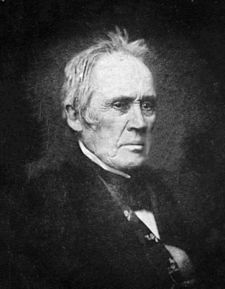Benjamin Silliman
| Benjamin Silliman | |
|---|---|

Silliman around 1850
|
|
| Born |
August 8, 1779 Trumbull, Connecticut, United States |
| Died | November 24, 1864 (aged 85) New Haven, Connecticut, United States |
| Nationality | United States |
| Fields | chemist |
| Institutions | Yale University |
| Alma mater | Yale University |
| Doctoral students | James Dwight Dana |
| Known for | Distillation of petroleum |
| Notable awards | National Academy of Sciences |
Benjamin Silliman (August 8, 1779 – November 24, 1864) was an early American chemist and science educator. He was one of the first American professors of science, at Yale College, the first person to distill petroleum in America, and a founder of the American Journal of Science, the oldest continuously published scientific journal in the United States.
Silliman was born in a tavern in North Stratford, now Trumbull, Connecticut, a few months after his mother, Mary (Fish) Silliman (widow of John Noyes), fled for her life from their Fairfield, Connecticut, home to escape two thousand invading British troops that burned Fairfield center to the ground. The British forces had taken his father, General Gold Selleck Silliman, prisoner in May 1779.
Silliman was educated at Yale, receiving a B.A. degree in 1796 and a M.A. in 1799. He studied law with Simeon Baldwin from 1798 to 1799 and became a tutor at Yale from 1799 to 1802. He was admitted to the bar in 1802. President Timothy Dwight IV of Yale proposed that he equip himself to teach in chemistry and natural history and accept a new professorship at the university. Silliman studied chemistry with Professor James Woodhouse at the University of Pennsylvania in Philadelphia and delivered his first lectures in chemistry at Yale in 1804. These lectures were the first science lectures ever given at Yale. In 1805, he traveled to Edinburgh for further study.
Returning to New Haven, he studied its geology, and made a chemical analysis of the meteorite that fell near Weston, Connecticut, publishing the first scientific account of any American meteorite. He lectured publicly at New Haven in 1808 and came to discover many of the constituent elements of many minerals. Some time around 1818, Ephraim Lane took some samples of rocks he found at an area called Saganawamps, now a part of the Old Mine Park Archeological Site in Trumbull, Connecticut, to Silliman for identification. Silliman reported in his new American Journal of Science, a publication covering all the natural sciences but with an emphasis on geology, that he had identified tungsten, tellurium, topaz and fluorite in the rocks. In 1837, the first (and at the time only) prismatic barite ore of tungsten in the United States was discovered at the mine. The mineral sillimanite was named after Silliman in 1850. Upon the founding of the Medical School, he also taught there as one of the founding faculty members.
...
Wikipedia
